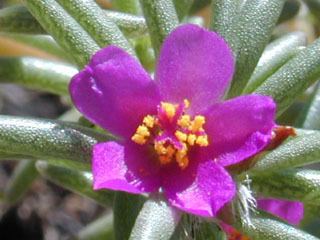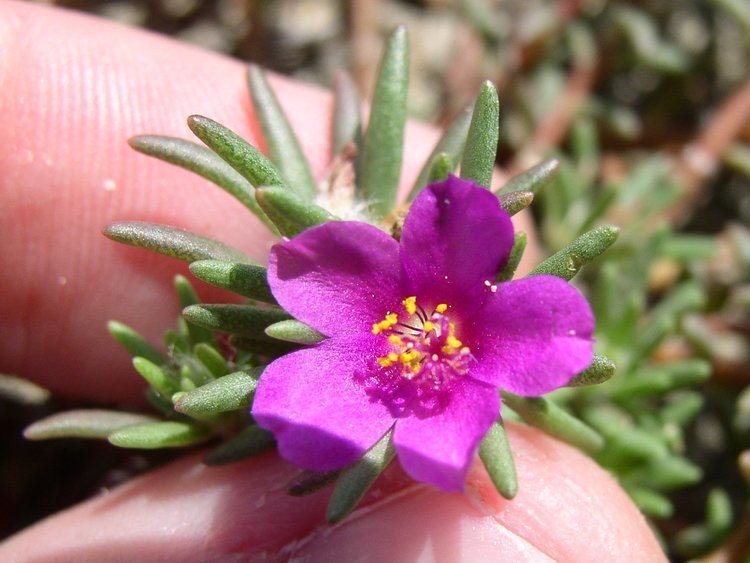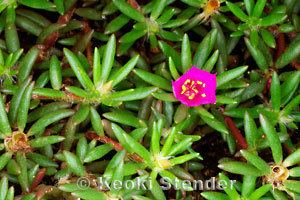Scientific name Portulaca pilosa | Genus Portulaca Rank Species | |
 | ||
Similar Purslanes, Portulacaceae, Wingpod purslane, Portulaca halimoides, Portulaca grandiflora | ||
Portulaca pilosa is a species of flowering plant in the purslane family, Portulacaceae, that is native to the Americas. Its common names include kiss-me-quick and hairy pigweed. Its range extends from the southern United States and the Caribbean as far south as Brazil. It is a succulent with linear leaves and pink flowers.
Contents

Description

The name is derived from pilose, which means to be covered with long soft hairs. Portulaca pilosa is a highly variable species. It exhibits morphological variability during development with the immature plants having a wider, longer and flatter leaves than its mature counterparts. The mature leaves are narrower, shorter and more hemispheric in cross section.

Physical differences may also occur due to the variable habitat that this species can be found in. Plants that grow in an arid environment tend to the greatest density of hairs. Plants that grow in a moister environment tend to have less hairs. Plants with very dense hair under a certain condition will produce growth with fewer hairs under a moist condition, showing its variability of growth. Habit is also governed by its habitat. Plants growing in moist, warm environments tend to branch rather quickly into a spreading habit, with a secondary growth which is erect. Plants in dry and cool environment do the opposite in that they grow erect first and then branch more slowly. This type has a more compact habit.

Specimens from Alabama, Arizona, Florida, Louisiana, Mississippi, Texas, and New Mexico exhibit all morphologic conditions. Those from Arkansas, Kansas, Missouri, and Oklahoma usually tend to occur in shallow, sandy soils, often on rocky outcrops, and are often highly branched, compact, short, and not very pilose (hairy).
Location

Portulaca pilosa is a pantropical species native to Asia. In the Americas P. pilosa can be found in Mexico, West indies, Central America, and as far south in South America as Brazil. And in the United States, they are typically concentrated in the southern parts such as Arkansas, Texas, New Mexico, Florida, Mississippi among other states. P. pilosa is a documented invasive species throughout the Hawaiian Islands, the Galapagos Islands, New Caledonia, and Christmas Island (PIER.org 2012). In Hawaii, P. pilosa is officially documented from the coastline to dry lava flows at over 2,000 feet in elevation yet can be found up to nearly 6,000 feet in the Pohakuloa Saddle region.
Characteristics
The plants are annual, and the flowering can be from late spring to early fall. They grow and flower year-round in south Florida. This plant is somewhat unusual in that it can grow under a range of different environments, including dry soils, beaches, and disturbed habitats. This plant also grows on roadsides and railroads, on limestone, granitic, and sandstone outcrops.
Structures
The roots are fibrous to semi-fleshy. The trichomes are rather obvious at the nodes and are in inflorescence. The branch size range from 3-25 centimeters. The leaf blades are linear to oblong-lanceolate, which is intermediate of the two. They can also be terete to hemispheric, with a range of size (5-20 x 1–3 mm). The plant has an acute apex with involcure-like bract of about six to nine. Flowers range from .5 to 1.2 centimeters in diameter. The color of the petals can range from darkish pink to purple. The flower shape is obovate with 3-5 x 1.5-3 millimeters in size. The stamens in size of 5-12 millimeters but can reach up to 37 millimeters. The stigmas can be of the size of between 3-6 millimeters. The capsules are oval with a 1.5 to 4.3 millimeters in diameter. The seeds are black or leaden with a nearly circular shape. The size ranges from .4 to .6 millimeters in diameter. The surface cells are loosely arranged. The number of chromosomes is 16, which is 2n = 8.
Uses
It has been said that the species of Portulaca pilosa in Brazil has been used as a traditional remedy to cause diuresis, antipyresis and analgesia. Studies have shown that its extracts have renal effects. It has also been seen that in rats, such extracts cause an increase in potassium excretion without a concomitant change in water diuresis or sodium excretion. Studies reveal that this species also inhibits tyrosinase in mushrooms in vitro.
